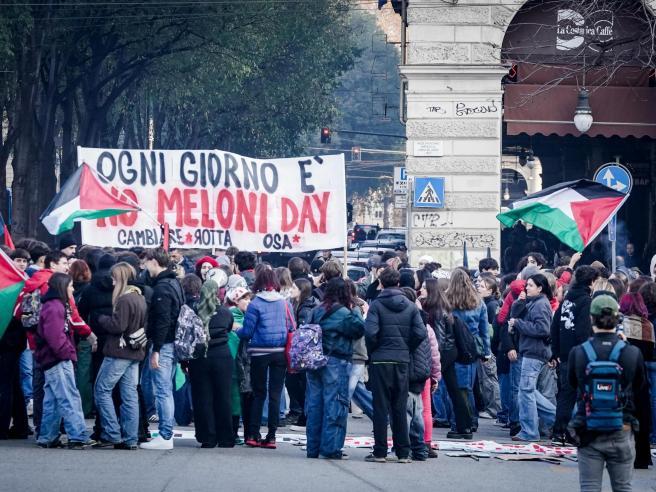by Stefano Piazza
In Italy, the link between pro-Hamas groups and the far left is increasingly strong with leftist political forces remaining silent or nearly silent. It was a Friday of very high tension in 30 Italian cities where thousands of students took to the streets for “No Meloni day’: slogans, placards, burned mannequins, photos of ministers daubed in red and even clashes in Turin, where 20 policemen were injured and there was a raid at the Mole Antonelliana. “These violent rioters who today put our cities to the sword, using the flag of Palestine as a justification for violently attacking law enforcement, must pay for their nefarious deeds. They are violent thugs not protesters. Destroying houses and cars, burning public property, injuring policemen and carabinieri, has nothing to do with the manifestation of a thought, with a legitimate political struggle, it is just a crime. Like them, those who pretend not to see them or defend them are also to be morally condemned because by doing so they create the humus for an increase.” So wrote Defense Minister Guido Crosetto on X referring to some episodes that occurred for the “No Meloni day” and, in particular, to the riots in the city of Turin.
As mentioned, the biggest problems occurred in Piemonte capuologue: in the procession that left from Porta Susa station, the pro-Pal component was also present, with antagonists close to the “Askatasuna” social center historically representing a major security problem for the city. The protesters — several hundred of them — set fire to a puppet with the photo of Education Minister Giuseppe Valditara, daubed buses and several monuments, tore down the Italian flag from the Cinema Museum to replace it with the Palestinian flag. They dredged up from the 1970s the gesture of three fingers in the air to symbolize the P38; threw eggs and firecrackers at police officers deployed in Piazza San Carlo, which was followed by a confrontation in front of the prefecture in Piazza Castello.
The Black Friday toll speaks of at least 20 officers who were injured, most from the detonation of a crude device containing a stinging gas that caused chlorine poisoning. In Rome, the student procession reached the Ministry of Education and Merit. At the head a banner of the collectives with the inscription, “ Against a government of fascists and Zionists”.Here the participants applied red paint on signs with the faces of Meloni and ministers Valditara and Bernini to symbolize “ the hands stained with blood for the genocide of the Palestinian people.”
As ANSA news agency reports, they then wrote the phrase “Ministry of War” on the asphalt in front of the Ministry and pasted some Palestine flags on the wall. “No Meloni day” also took place in Milan, where the procession was opened by a banner that read, ” Students in revolt against repression, genocide and merit.” A photo of the premier with her face smeared with red paint and many Palestinian flags also appeared. In Naples in front of the Maschio Angioino monument, students displayed a banner, “ Money for school and not for war,” and smoke bombs were thrown during the passage.
The government reacted and the Minister of the Interior, Matteo Piantedosi said “ that there was no pretext for other ongoing initiatives or subjects to oppose (the reference is to last Saturday’s clashes in Bologna, ed.) but it was the buildings of the institutions that were targeted and the police force workers deployed in their defense who were attacked. I trust that firm condemnation of what happened can come unanimously.” According to Minister of University and Research of the Italian Republic Anna Maria Bernini, “the clashes are the culmination of a climate of hatred that had to be crushed immediately and stigmatized by all. Without any distinction.” Elly Schlein, secretary of the Democratic Party, intervened on what happened, once again using the affair to attack the government: “Solidarity and closeness with the injured law enforcement officers. The right to protest, to demonstrate and to strike cannot and must never,” she argued, ”be confused with violent aggression against anyone. Violence is intolerable, as is,” he adds, ”the political instrumentalization of violence, which no one, especially those with government responsibilities, should do. There are many questions about what is happening in Italy, and one in particular: who is paying for all the flag-waving and protesting by these professional street protesters, and who paid for the riots organized in Italian universities exactly as in American universities? The question deserves an answer from the authorities even though we fear we know the answer.

